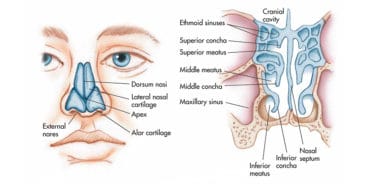Nasal concha is a tissue that filters and moisturizes inhaled air. Nasal Concha Growth may cause health problems if it swells and grows due to allergies, infections and nasal bone curvature. Some of its symptoms are nasal obstruction and breathing difficulty. It can be temporary or permanent. In temporary cases, medication is usually administered. In permanent cases, nasal concha can be reduced by radiofrequency or laser surgery. If nasal concha is very large, some part of it can be removed with conventional surgery method. This is longer than other methods. It can lead to more severe side effects such as pain and bleeding. If the instructions of the doctor are followed, the success rate increases.
Table of Contents
What is a nasal concha?
Nasal concha is filled with a network of blood vessels filtering, heating, moisturizing the inhaled air and directing it to the lungs. These structures, also called turbinates, are on nasal cavity walls. There are three pairs of turbinates being the inferior, middle, and superior, leading to 6 in total.
When one of conchae is filled with blood and swollen due to factors such as allergens, it becomes difficult to breathe. This health problem usually, occurs in inferior and middle concha. Nasal Concha Growth or Enlarged inferior turbinate is mostly seen in adults. (1)
Causes of Nasal Concha Growth
When the veins in nasal concha are filled with blood, it leads to swelling or growth of the nose. Nasal concha swelling can be acute or chronic.
Common causes of temporary nasal concha growth developing abruptly are as follows:
- Weather changes (e.g. nasal concha swells more in winter)
- Allergies to dust, mold etc.
- Some of Drugs
- Stress and anxiety
- Hormonal changes such as pregnancy
Common causes of chronic nasal concha growth are as follows:
- Seasonal or severe allergies
- Chronic nasal infections such as sinusitis
- Septum deviation (nasal bone curvature)
- Air pollution
- Cigarette smoke
Many people with chronic concha swelling have a history of allergic rhinitis (hay fever) in their family, especially in the spring.

Symptoms of Nasal Concha Growth
- Long-term nasal obstruction
- Runny nose
- The feeling that there’s something in the nasal cavity
- Pressure and pain in the forehead and around the eyes
- Change in sense of smell
- Snoring
- Mild facial pain
- Xerostomia
Nasal concha swelling causes a permanent common cold effect. However, if it is mild, it usually does not cause any discomfort.
Diagnosis of Nasal Concha
- If you have difficulty breathing through the nose, your doctor will examine the inside of your nose using a medical instrument called a nasal speculum
- Endoscopy, can be used to examine posterior sides of nasal concha
- If necessary, a computerized sinus tomography or magnetic resonance imaging (MRI) may be taken to determine the exact size and position of the nasal concha
- Enlarged nasal concha appears in the form of black dots (or circles) within the surrounding structures.
Treatment of Nasal Concha Growth
The treatment process depends on the cause of swelling of nasal flesh and the discomfort it causes to person. Acute concha swelling is usually treated with medication. Your doctor may make recommendations to eliminate conditions that can cause swelling of nasal flesh.
However, in case of a chronic condition, one of surgical techniques can be decided by removing a portion of the nasal flesh or shrinking it with heat.
Medications for Nasal Concha Growth
- Medicines such as Cetirizine (Zyrtec) or loratadine (Claritin, Allegra) may be prescribed to relieve seasonal allergies.
- In cases of nasal infections and allergic rhinitis, oral decongestants (nasal relievers) such as pseudoephedrine may be used. However, these drugs should not be taken by people with blood pressure problems.
- Nasal corticosteroid sprays can also be used in drug treatment. However, long-term use of these sprays can cause bleeding or drying in the nose and the effect may decrease over time.
Nasal Concha Growth Surgery
Nasal Concha Growth Surgery Considerations
People who are eligible for nasal concha surgery are as follows;
- Those whose nasal concha is constantly growing due to genetic or allergic factors
- Those with nasal bone curvature problem,
- Those whose both or one of the nostrils are constantly obstructed,
- Those with persistent breathing difficulties,
- Those with sleep apnea,
- Those aged over 16 with abnormal nasal concha. However, it is very rarely recommended for people aged over 65.

Nasal Concha Growth Surgery Procedure
Radiofrequency or laser surgery
These methods are performed in at least two visits to reduce the size of nasal concha without removing bone or tissue. A special needle-like instrument is used during the surgery. Nasal conchae are heated and reduced in size.
This surgery takes at least 10 minutes and is performed under local anesthesia. Local anesthesia is administered into the nasal tissues using a needle. Patients have an outpatient treatment and can return to routine work after a day.
Side effects are minimal. Crusting or nasal dryness can be experienced for about 3 weeks. During this period, nasal wash with saltwater and using antibiotic ointment can help control the side effects. After three weeks, the injured tissue fully recovers. (2)
Nasal Concha Resection or Reduction
It is a method generally used in severe nasal concha swelling. Under general anesthesia, a part of bone underneath the nasal concha is removed to reduce the size of it. Moreover, a hand-held instrument can be used to open the nasal cavity more by abrading some of the tissues around the nasal concha. The process usually takes 20 or 40 minutes.
Along with this surgical intervention, septoplasty (correction of the curvature of the nose) surgery can also be perform. In this case, the surgery may take 2 hours. In septoplasty, the nasal cavity is cut to correct the septum. Following the surgery, a tampon is placed in the nasal cavities. The tampon is usually removed after 3 days. You may need to stay in the hospital for 2 or 3 days.
Side effects are pain, bleeding, swelling, irritation, dryness of the nose, and infection. In addition, a further surgery may be required as the growth of the concha may be repeated after the surgery. Recovery period is 3 or 6 months. (3)
What to do after nasal flesh surgery
- Avoid exhausting activities and protect your nose against bumps to prevent possible bleeding and swelling for 3 weeks after surgery
- Use 2 or 3 pillows to keep your head up while you sleep
- Wear front-button clothing to avoid irritating your nose
- You can shower without running water into your nostrils on first postoperative day
- Avoid blowing your nose for a few days. Otherwise, bleeding may occur
- Follow the instructions of your doctor and do not neglect the control visits
Recommendations for nasal concha swelling
Some simple methods can be applied at home to prevent acute nasal concha problems, especially caused by allergic reasons. These are as follows:
- Regularly clean your living and working environment to remove dust. For example, you can protect your bed against dust mites by using a dust-proof bed cover
- Clean mold in bathrooms and kitchens with special cleaners
- Use an air filter in your bedroom to help remove dust
- Choose to wear clothes made of non-allergic fabrics, such as cotton, instead of synthetic clothes
- If you have a pet, clean the hair frequently and do not let them into your bedroom
- Clean your nose every day with salt-carbonate water solution
- Avoid smoking indoor





